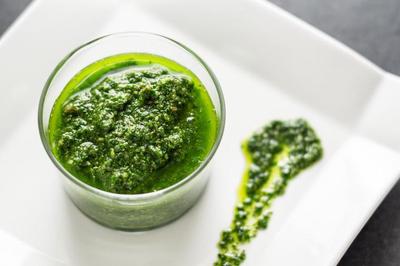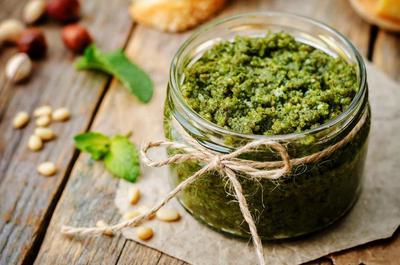🍃 Can Dogs Eat Pesto - Toxic? All the facts
Well Pesto is healthy right? Read this first! - We uncover the truth behind this popular tasty sauce 🍃

Summary
If you are wondering whether or not to feed pesto to your dog, the answer is yes and no. Yes because it’s delicious and nutritious; but no because there can be some ingredients that may cause problems in dogs digestive systems. If you want to give your pet this tasty treat, keep reading.
Can dogs have pesto?
Pesto, a delicious mixture of basil leaves, garlic, pine nuts, olive oil, cheese, salt and pepper, has been around since the 1960s when it was created in Genoa, Italy by chef Giorgio Locatelli. It’s now one of the most popular sauces on the planet. But can your dog have some too? And what are the dangers if they do? Let’s find out!
The short answer is yes. There are many benefits to feeding your dog pesto including improving his/her health 💚, boosting there immune system, reducing inflammation, preventing cancer, increasing energy levels, helping then lose weight and even relieve arthritis pain in dogs.
However, just like humans who consume large amounts of pesto, there could be potential risks associated with eating too much of it. So let’s take a look at them below.

Watch our for
Gastrointestinal Issues 👩⚕️
One of the main reasons why people stop consuming pesto is its high-fat content. When we talk about fats, we usually think of saturated fats such as butter and lard. These types of fats tend to increase cholesterol levels in our bodies. High cholesterol levels can lead to heart disease and other serious conditions.
Since pesto contains lots of healthy monounsaturated fats, it doesn’t raise blood cholesterol levels. In fact, studies show that regular consumption of pesto helps lower bad LDL cholesterol levels. That means that pesto can help prevent cardiovascular diseases.
However, excessive amounts of pesto can still affect your dog’s stomach. If they eats too much of this sauce, it may result in digestive problems such as vomiting or diarrhea. Some dogs might experience bloating after having pesto-based meals.
Urinary Tract Infections
Another reason why people give up on pesto is because they believe that it causes UTI symptoms in dogs. While it’s true that certain foods can trigger UTIs, not every type of food leads to these kinds of complications. As mentioned earlier, pesto does contain basil which can potentially cause irritation to your dog’s bladder.
If your dog suffers from frequent UTIs, try cutting down their exposure to basil. Alternatively, you can switch to another herb that doesn’t pose a threat to their kidneys.
Garlic & Tomato
These are toxic to dogs, if your pesto contains we recommend not giving it to your pup, the safest method is quite simply making your own which we discuss below.
Liver damage
This relates to the amount of pesto consumed rather than the ingredients themselves. A study published in the Journal of Veterinary Internal Medicine found that rats fed diets containing 10% of their bodyweight per day had liver damage. Similarly, a similar study conducted on mice showed that those given 20% of their daily caloric intake were prone to fatty liver disease. Based on these findings, experts recommend limiting how much fat your dog consumes each time. You should only feed them small portions of pesto so that they won’t get sick. Other health risks
Finally, while pesto itself poses no harm to your dog’s overall health, there are several other factors that need to be considered before giving it to him. Keep in mind that all herbs and spices can irritate sensitive stomachs. Always check the label of any commercial products you plan to use to avoid buying anything that contains artificial colors, flavors or preservatives.

Preparing pesto - dog friendly
Make sure that all of the ingredients are safe for dogs 🐕🦺. The first thing you should do when making any food for your pets is to make sure they don’t have allergies. You need to check with a vet if your dog has an allergy before adding anything new to their diet.
You’ll want to prepare homemade, special dog pesto, avoiding tomatoes and garlic as a pet owner. Next put everything into a food processor and blend to ensure it’s finely ground.
Ingredients in Pesto
- Be careful about what kind of oil you use. Olive oil contains oleic acid which can irritate sensitive stomachs. Other oils like sunflower seed oil contain linoleic acid which can also cause gastrointestinal issues. Choose olive oil instead.
- Don’t add garlic. Garlic can upset dogs' digestion system as well, in severe cases, it can break down your dog’s red blood cells, results in hemolytic anemia.
- Add salt sparingly, it can aggravate dogs' urinary tract infections. It’s better to limit their intake to less than 2 teaspoons per day.
- Keep the temperature low while cooking. Heat up the dish containing pesto until boiling point then reduce heat immediately
- Avoid giving more than two tablespoons of pesto per serving. Too much of anything isn’t good for dogs and this is rich.
Are pine nuts ok?
Although not toxic to dogs, pine nuts are not recommended as they are high in fat. Foods high in fat can cause gastric upset.
Dogs that do not tolerate dairy products may be sensitive to the protein found in Parmesan cheese. If you suspect this could be an issue for your pet, consult your veterinarian before feeding it to them.
Conclusion
So now you know why you shouldn’t feed your dog too much pesto. But does this mean that you cannot enjoy eating it yourself? Of course not! Just remember to follow these tips above and you’ll be fine. Pesto is a nice treat for your dog, providing you make it in the right way, including specific ingredients.